Howard Garrett speaks for orcas. Specifically, the co-founder and president of Orca Network, speaks passionately for preserving the endangered Southern Resident Killer Whale population of the Salish Sea, which includes Puget Sound and its surrounding waters.
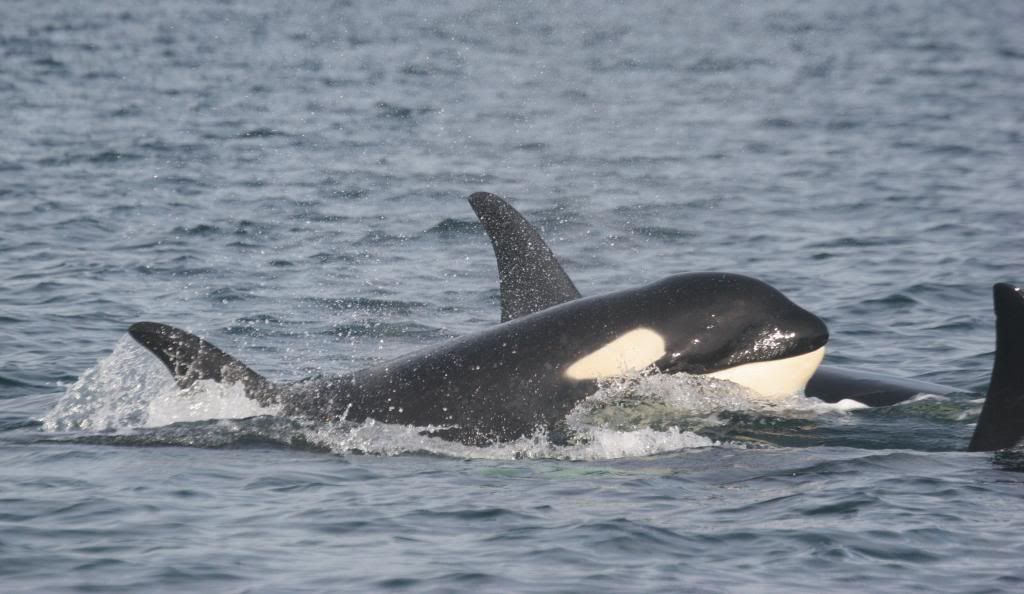
The Neighbors
.
In September of 2012, Garrett addressed a group of people who had gathered at Cherry Point to consider potential impacts of the proposed
Gateway Pacific coal terminal. Howard’s topic, as you might have guessed, was the orcas. He spoke of their lives, their families, their place in the ecosystem, and the urgent need to protect them from any further impact which might threaten them with extinction.
One of the most striking things about Howard’s talk was how he identified the orcas, clearly and without any equivocation, as self-aware individuals. He bases the assertion on decades of study and personal experience as an orca researcher. Orcas speak to each other; they live in communities and bond with each other at a level that matches or exceeds us humans at our best.
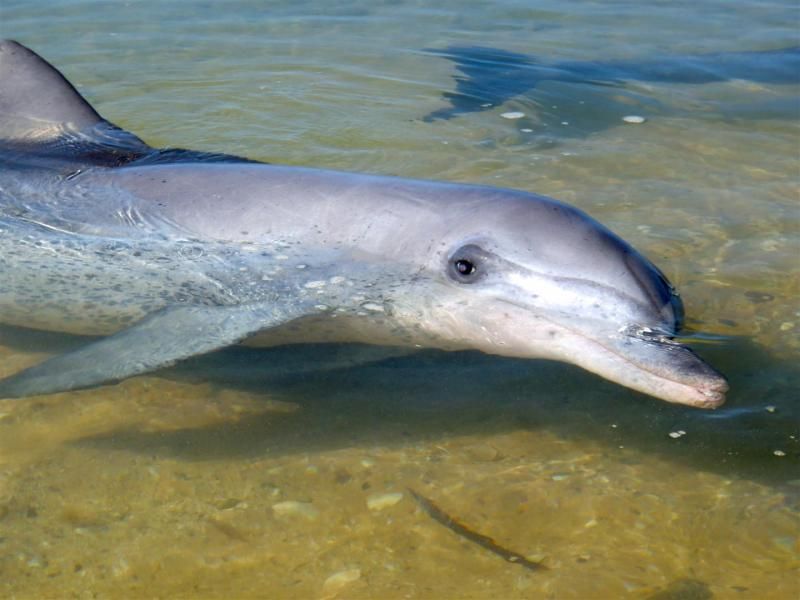
Here's Looking At You
As Howard described this, I was instantly brought back to an experience I had in 1988 at the seashore at
Monkey Mia in West Australia, where dolphins come in to visit humans. I stood in about two feet of water, holding a small fish and imagining I might get to feed some dolphins who have been conditioned to find a steady food supply at this spot.
The experience was very different. Each dolphin came in and rolled on its side in order to look directly at me. At about three feet range, there was no mistaking the recognition; they were coming to visit and check us out.
Sometimes one of the dolphins would allow you to touch it. You could directly feel the immense power in their muscles and realize the unmistakable fact that the dolphin was choosing to accept the touch.

Who is Training Whom?
It happened to be a watershed day — one of the first times that a second-generation dolphin visitor came in to the beach. Born just a few weeks before, the baby had been spotted out at sea but kept there by her mother. Today, mother and daughter came in to about fifty feet off shore, not in the wading zone but close enough for us to easily see, and — I’m sure — so that the baby could catch her first look at the strange terrestrials.
I came away with a clear understanding that very real intelligence and awareness is not limited to us. That kind of moment of clarity doesn’t go away; here in 2012, hearing Howard speak, it was easy to summon up the visual memory of a dolphin looking me right in the eye, as though probing to see what kind of intelligence might be looking back.
And orcas are the largest of the dolphin family. Everything I saw in those dolphins 25 years ago, orcas have, in abundance. Orcas have distinct communities that stay together throughout their life spans, which are roughly as long as a human’s. In fact, a recent study shows that male orcas swim with their mothers for their entire lives.
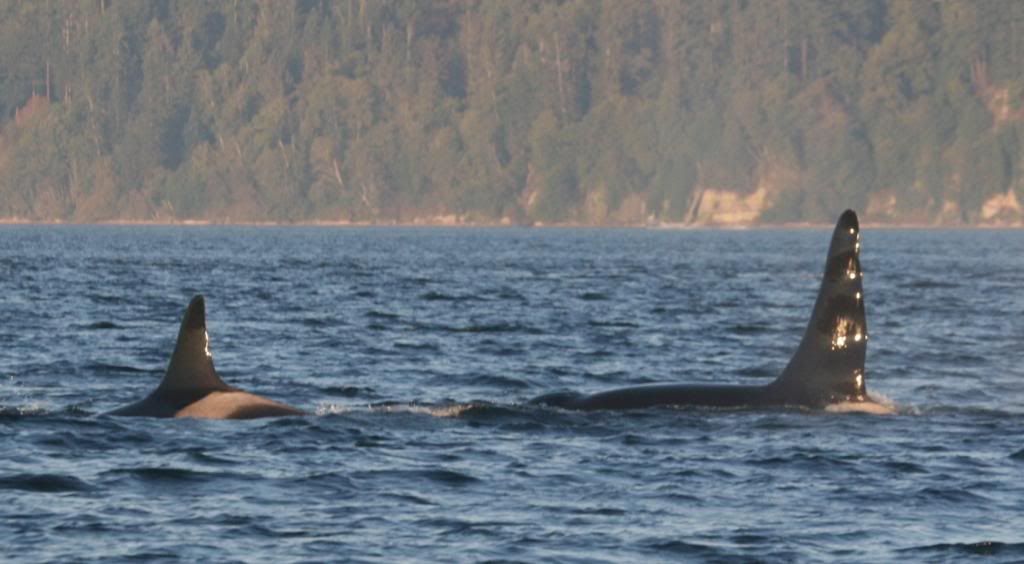
Ruffles swam with his mother for his entire life, an estimated 59 years. Mother "Granny" is estimated to be 99.
.
Orcas display a rich social interaction within their pods whenever they are observed. They swim together, play together, and hunt together. As Howard Garrett describes:
Their whole spectrum of how orcas behave is in the context of their cultural community. Populations of orcas retain their distinct populations and behaviors, even when they are in contact with other orcas in their same range. This tells us that their behaviors are products of learned and taught behavior.
This naturally brings up the question of language. Can orcas talk? It’s beyond dispute that they vocalize, and that the vocalizations, known as “calls,” are complex. The calls are distinct to each community of orcas, and orcas remember and use the same vocal patterns throughout their lives. In fact, it has been documented that our southern resident orcas even have a dialect of calls distinct from their northern resident cousins who inhabit the inland waters of British Columbia.
Considering the distinct populations of orcas that coexist in overlapping ranges, could one of the forces gluing together groups of orcas be their distinct language? In humans, language and culture are inseparable attributes of the same thing.
.
After the game, they had salmon dinner and talked about whether humans can experience joy.
Once reviled as “killer whales,” orcas have only been recognized in the past few decades (at least by non-native people) for their intelligence.
Not surprisingly, the documented cases most strongly capturing the public imagination have been where orcas and humans have interacted. An orca named Luna was separated from his pod in 2001 and appeared alone on the Northwest coast of Vancouver Island. Perceived as being lonely, Luna made many human friends and inspired advocates when he consistently interacted with people and boats.
Filmmaker and science writer Michael Parfit offered his view in a 2008 Seattle Times feature article by Stephan Michaels:
My sense of it is that the social need that he had and that we have, that we call friendship, is extremely complicated in our lives and in theirs. In the details it’s going to be different. But that big thing we think of as ‘friendship,’ which encompasses all of those emotional structures, is a good metaphor for what he needed and a good metaphor for what we sensed when we looked in his eye.
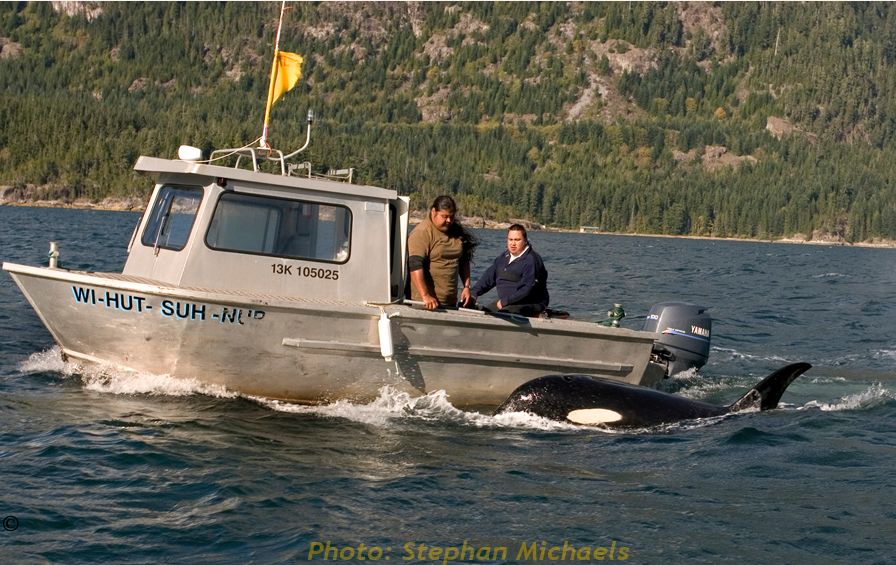
Luna, visiting with friends
.
Garrett cautions that while human interactions with orcas get the headlines, this may miss the larger point of the lives and culture of the orcas. “Most of the time they ignore us because they are busy with their rich social world,” he says.
Other scientists and ethicists have advanced the cause of recognizing and respecting the intelligence and dignity of cetaceans. In 2010, a group of experts in the field, organized as ‘The Helsinki Group’ issued the Declaration of Rights for Cetaceans: Animals and Dolphins. The declaration states, in part:
We affirm that all cetaceans as persons have the right to life, liberty, and wellbeing.

Dr. Lori Marino:
Perhaps she'll discover
self-awareness in humans next
What’s notable about the declaration is the use of the term ‘persons’ to refer to cetaceans. The declaration is based on the concept that cetaceans should be regarded as a type of person.
The written work of the eleven signatories is a trove of information about the astonishing traits of cetaceans, including orcas and dolphins. For instance, Dr. Lori Marino of Emory University was first to publish in 2001 (with Diana Reiss), a proven demonstration that dolphins can recognize themselves in a mirror, a strong indication of a high level of self-awareness. Each of the parties to the declaration feature lengthy lists of publications on the environment, biology, ethics, and policy.
Dr. Paola Cavalieri, author of the book “The Animal Question: Why Nonhuman Animals Deserve Human Rights,” (New York, Oxford University Press, 2001) explains in a column in the UK paper, The Guardian:
Scientists have explained to us that whale societies display complex and stable vocal and behavioural cultures previously suggested only for humans. More impressively still, research into whale behaviour points to an ability to look to the past, present and future — functions on which consciousness of oneself as a distinct entity existing in time are mounted.
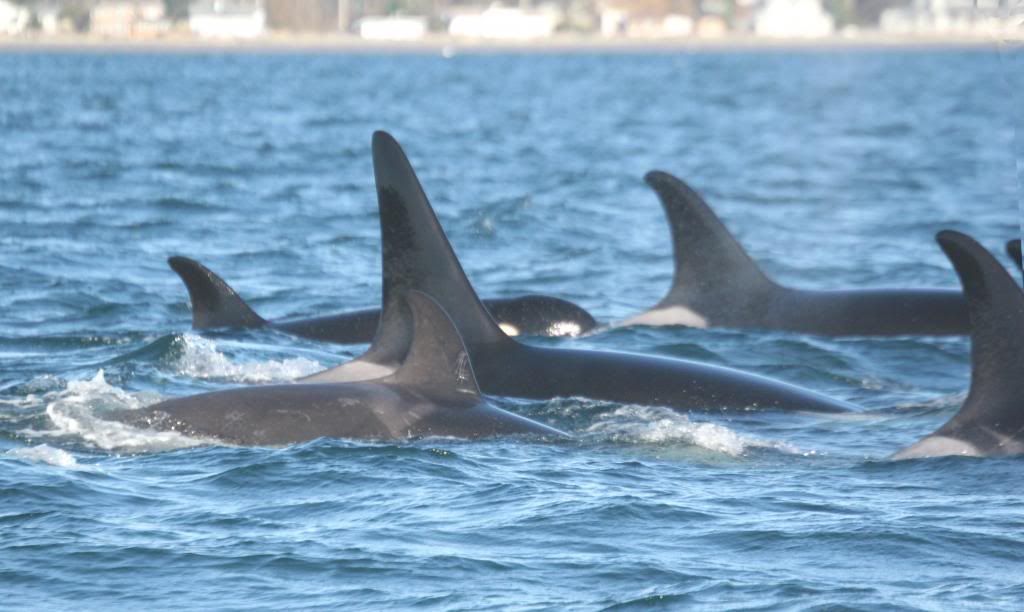
Pod, Tribe, Family
.
Ok, so the orcas and whales in general are a great wonder. But — people?
This directly brings up a question of definition. When we say “people,” it’s impossible to shake the part of the definition that implies ‘a member of the species Homo sapiens.’ By definition, our language doesn’t allow us to acknowledge that we might have peers outside of our species. And in most cases, if you can’t say it, then you can’t even think it.
The separation is so hard-baked that it even violates any kind of consistency. If you say “animals,” the convention automatically excludes humans, even though of course we are animals.
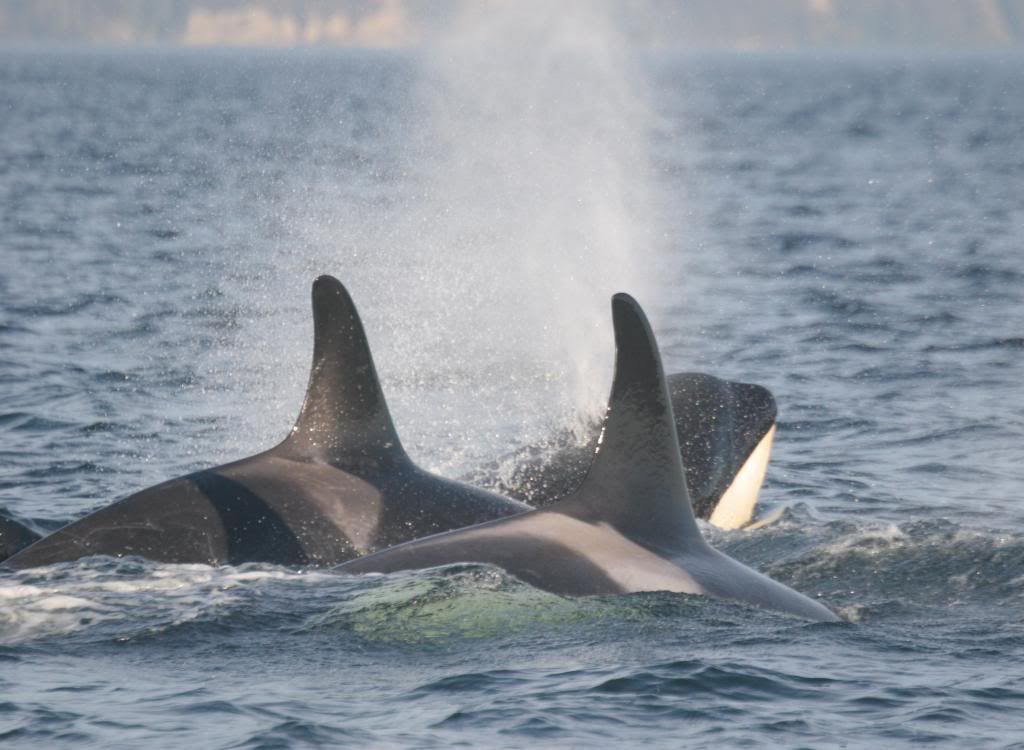
We are animals, too
.
Let’s look at another word. Scientific papers have evaluated the existence of
culture among orcas. An example is this extensive
2001 paper by Rendell and Whitehead. If you wade through its 74 pages, there is some compelling information about the existence of culture among the orcas. But the word ‘culture’ is another term that is assumed to be explicitly limited to humans.

Dr. Thomas White:
A person who explores the question
Of who else may be a person
.
I have used the term ‘human’ to refer to the species Homo sapiens (you know, us), but even that term is loaded. Being human means to have the qualities of compassion and insight that, convention tells us, separate us from the (rest of the) animals. Again the assumption, our clear distinction from all others, is buried deeply in the language.
The most direct effort to show a clear difference between ‘human’ and ‘person’ comes from Dr. Thomas White, author of the book “In Defense of Dolphins: The New Moral Frontier,” (Malden, MA, Blackwell Pub., 2007) as well as many papers on the topic. He uses the term ‘Non-human person’ to draw clear attention to the idea that the terms should be separated.
He explains:
In everyday language, most of us use ‘human’ and ‘person’ interchangeably. But philosophers distinguish between the two, seeing ‘human’ as a scientific concept and ‘person’ as a philosophical concept. Human refers to any member of the biological category homo sapiens. Person refers to the combination of advanced traits by which we define ourselves — things like self-consciousness, intelligence, and free will.
In a similar vein, Dr. Marino says:
If you make a list of the qualities that define humans as being people, such as self-awareness and the ability to consider the future, and if you then apply the same criteria to certain other animals like cetaceans, you will find that they also qualify as people. But you can only conduct that analysis in a rational manner if you set aside your prior idea of what the answer is.
So a key aspect of the question is: Do you define “people” based on a set of qualities, or do you define it as most people (oops, most humans!) commonly understand it? There may be no definitively correct answer.
In pondering this question – are orcas people? — we should consider that perhaps the reason the question can’t be answered is that the question itself may just be wrong. To ask whether orcas are people is to accept the hard barrier between those who are people and those who are not. Let’s say, per chance, that a consensus emerges in which orcas, or perhaps whales generally, are ‘people,’ and we vault them over that hard line. They get to join humans in this select category that excludes all other living things. Have we advanced our understanding? I think we have not.
As for most questions that matter, the best answer is not the simplest. When pondering whether orcas could be our peers, the question might be best answered by lowering the defined barrier between people and not-people. Perhaps then, we might view orcas, and other animals, as our kin who may be close or distant. Then we might see that we are all animals, instead of just some of us being people.
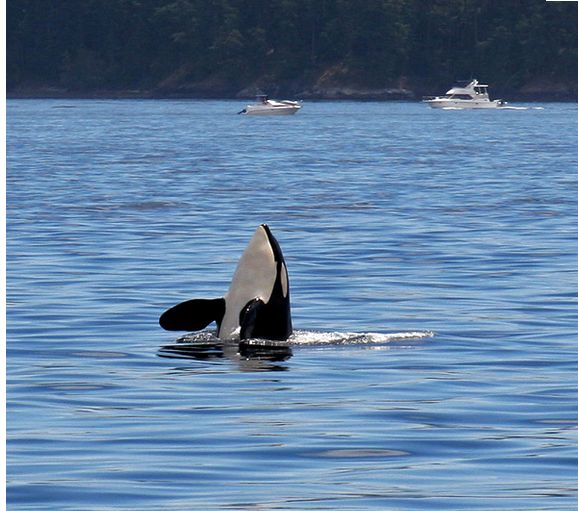
We can show some respect for Granny
And the rest of her family
.
This prompts us to try to understand orcas for who they really are, instead of trying to stuff them into a human-defined box, where they must have qualities like us humans in order to be accorded any respect. It doesn’t matter whether they are like us or not. If they have culture, it’s their own culture. If they have language, it’s their own language. And their indisputable intelligence is: orca intelligence.
This broader understanding, of us and our kin in the animal kingdom, could help us commit to providing long-term habitat for the life that we share the planet with. Maybe, just maybe, it would help us do real work to preserve our overall climate and environment for all of us living beings.
Absent the bright white line, it’s not a simple or easy path of inquiry. There will be grey areas, ethical dilemmas, and places where good people can disagree. But if we claim for ourselves the name of sapiens, meaning ‘wise,’ then perhaps we can earn that label by showing we are up to the task.
News Items and Actions
A petition has been filed to Delist the Southern Resident Killer Whale from the Endangered Species Act: NOAA Info Here
Sign a petition saying 'Don't Do That!" Here
This Saturday January 26th, you can attend The Ways of Whales workshop on Whidbey Island.
Thanks To
• Howard Garrett for his original talk, a phone interview, photos, and review and comments on the text
• Stephan Michaels for substantial writing and editing help on the text. The special event at Cherry Point referred to in the article was organized by Stephan, together with the Surfrider Foundation.
• Lori Marino for a phone interview, and review and comments on the text
• Tom White for a phone interview
• Nicole Brown for several discussions about the cultural context in which language is interpreted
• Phil Damon for review and some corrections
• Dolphin photo courtesy of Wula Guda Nyinda Eco Adventures, Shark Bay, West Australia. Looks really great: "Discover the secrets of a beautiful land and understand the deep spiritual connection between the Nhanda and Malgana people and country."
• Dolphin photo by Brooke Sargeant, provided by Shark Bay Dolphin Project
• Whatcom Watch, our community newspaper here in Whatcom County WA, for publishing the paper version of this article, and then online.
Also check out this Whatcom Watch article by Howard Garrett, listing some of the ways that the proposed Gateway Pacific coal terminal would harm the orcas.


